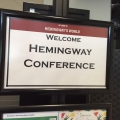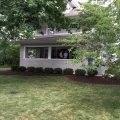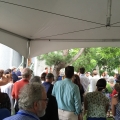Whenever I travel to a Hemingway Society conference, it feels less like going to an academic gathering than like taking a trip to spend time with friends I don’t get to see all that often. Like a family reunion, though one you don’t dread or don’t find to be a profoundly exhausting experience. Or perhaps like a high school reunion that happens more often than every ten years. I’ve taken to referring to our biennial meetings as “Hemingway Summer Camp,” differentiating it from gatherings in the vein of James Joyce, Samuel Beckett, or T.S. Eliot summer school. It conveys the sense of community and connection that exists in the Hemingway Society, something I believe makes it special and that keeps me coming back every time. It is what makes these conferences not just something I do for professional reasons but rather something I truly enjoy.
This year’s gathering commenced at Hemingway’s boyhood home in Oak Park, Illinois with tours of that home as well as an opening reception held in the backyard following the tours. What I found most interesting about our visit to Hemingway’s boyhood home was that it was still being used as a home. Today. People actually were living there. It reminded me of going to see Philip Roth’s home in Newark a few years ago for a Roth conference. We did not go inside but, much like with Hemingway, there was a plaque dedicated to the importance of the location and we all stood outside and looked in and imagined what it was like for the author to grow up there. But with Hemingway’s boyhood home, we were not only allowed to see it from the outside but also to take a tour of the inside with docents guiding us through and pointing out features of the house that have remained the same from when Hemingway lived there. It reflects the dedication that the community of Oak Park has for Hemingway that Mary Jane and Kurt Neumann, the current owners of the home, would be willing to let countless members of the Hemingway Society pass through and connect to Hemingway’s life and adolescence in Oak Park. The Neumanns even keep one room in the house in the style of Hemingway, with paintings of a ship hung on the wall and a typewriter sitting on a desk in front of a big window facing out onto the Oak Park street. Our visit was less like going to a museum in which you passively take in historical facts and information but rather like being given a window into the past so you could understand, at least in some small way, what life looked like for the young Hemingway. The quaintness of the streets, the impressive trees, the Victorian homes filling the neighborhood, the way in which everything seemed to flow into the hearth of the home and thus reflecting the eminent presence Hemingway’s mother played in his life and mind, I found my visit to be more revealing than going to a building with numerous historical artifacts taken out of context and put on display. I, along with all the other attendees, are quite thankful that Mary Jane and Kurt were willing to accommodate us and let us share in this bit of literary history that they own.
After the tour, we adjourned to the backyard for the conference’s opening reception. While eating hors d'oeuvres of fresh tomatoes, mozzarella, and basil as well as chicken skewers and sipping beer, wine, sangria, or other soft drinks, Hemingway scholars and aficionados all milled about and had a chance to connect (or re-connect). I had a chance to see people I hadn’t seen since the previous Hemingway conferences in Venice and Petsokey, to see dear friends who I correspond with via e-mail and Facebook but don’t get to see in person all that regularly, to meet and welcome newcomers to the Society who were attending their first Hemingway Society conference, to talk about what was going on in our lives and what we are working on these days. It was a balmy midsummer evening in the suburbs of Chicago (I was definitely feeling a big overheated since I was wearing a coat and tie, but as a man whose sartorial choices were once noticed and complimented by Scott Donaldson I felt as though I had a reputation to uphold) but the cold drinks and the occasional gust of a breeze kept things from being too oppressive. The robust conversation continued unabated, save for brief remarks from our conference director in Oak Park Alex Vernon, the Hemingway Society’s president, H.R. Stoneback, and from the president of Dominican University, Donna Carroll. Following those remarks by three people who worked very hard to get this conference together and running, there was the acknowledgment of those graduate students who received Hinkle travel grants to help defray the conference expenses. It felt very appropriate as the society acknowledged those burgeoning scholars who will help to shape Hemingway scholarship in the future and continue this community that had been established. It was a good note to end on and we left Hemingway’s boyhood home to continue the conversations we’d been having over dinner and drinks, looking forward to what lay ahead in the coming days.


